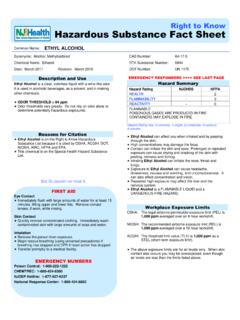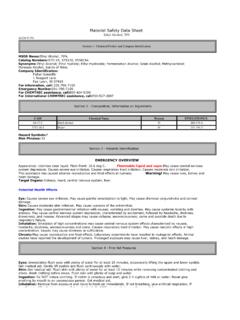Transcription of Latent Fingerprint Processing Techniques - Selection ...
1 Latent Fingerprint Processing Techniques - Selection & Sequencing Guide Chesapeake Bay Division International Association for Identification Page | 1 Copyright 2010 Chesapeake Bay Division - International Association for Identification (IAI), revised by Lindsay Jung About This Program Special thanks to Alexander Mankevich, Forensic Scientist Advanced for Maryland Department of State Police, the original creator of the Interactive Chemical Reagent Program. About this Program: Latent Fingerprint Processing Techniques - Selection & Sequencing Guide. The focus of this program is to provide background and guidance regarding a Latent Fingerprint Processing technique 's capabilities, applicability, incompatibilities and sequencing in order to guide an examiner in his/her Selection of an appropriate technique .
2 This program is the collaborative efforts of members of the Chesapeake Bay Division - International Association for Identification (CBD-IAI). The information about Latent Fingerprint Processing Techniques benefits from the collective wisdom and experience of CBD-IAI member examiners from federal, state and county forensic laboratories. Although some information is provided, this program does not comprehensively cover other important aspects to the Selection of Latent Fingerprint Processing Techniques such as safety, quality control, etc. For more detailed information regarding safety, alternative chemical formulations, quality control - quality assurance, chemical disposal and storage issues you are advised to consult the reagent's Material Safety Data Sheet (MSDS), and/or the literary references provided at the bottom of each reagent's page.
3 The Chesapeake Bay Division of the International Association for Identification (CBD-IAI) makes this program available to all Latent print examiners by clicking "BACK TO START". This program is one example of the CBD-IAI providing professional guidance and instructional services to the Identification Community. Any corrections, concerns or suggestions regarding this program may be addressed to: Da-il Kim, CBDIAI webmaster Bureau of Alcohol, Tobacco, Firearms and Explosives (ATF) - Forensic Biologist E-mail: Page | 2 Copyright 2010 Chesapeake Bay Division - International Association for Identification (IAI), revised by Lindsay Jung Disclaimer Persons choosing to prepare, apply and store any of the Latent Fingerprint Processing Techniques and reagents outlined in this program do so at their own risk.
4 You are advised that some chemicals are classified as hazards, harmful, toxic, irritants, flammable, etc, and that improper or inattentive use or misuse of any of these reagents may result in (but not limited to) skin, eye, respiratory or mucus membrane damage/injury, or the staining of skin, clothing or physical objects. Persons are urged to avail themselves to the instructions and precautionary notes found in the Material Safety Data Sheets (MSDS) and/or the literary references provided at the bottom of each reagent's page before engaging in the use of the Latent Fingerprint Processing technique . Observe all federal, state and local environmental disposal regulations. State and local disposal regulations may differ from federal disposal regulations. The Chesapeake Bay Division - International Association for Identification (CBD-IAI), its Officers, Board of Directors, Members, or any of the agencies and their members contributing their knowledge and experience to this program, assume no liability or responsibility for damage or injuries (personal or property) that may result from persons engaging in any of the Latent Fingerprint Processing Techniques outlined in this program.
5 Page | 3 Copyright 2010 Chesapeake Bay Division - International Association for Identification (IAI), revised by Lindsay Jung Latent Fingerprint Processing Techniques 1. AMINO ACID Techniques o Cyanoacrylate Ester o o 1,2 Indanedione o 5-MTN o Ninhydrin 2. ADHESIVE TAPE SURFACES o Gentian Violet o Liqui-Drox o Liqui-Nox o Sticky Side Powder 3. BLOOD Techniques o Amido Black - Methanol o Coomassie Blue o Crowle's Double Stain o o Leucocrystal Violet 4. CARTRIDGE CASES o Basic Yellow 40 o Cyanoacrylate Ester o Gun Bluing 5. ECCRINE Techniques o Cyanoacrylate Ester o o 1,2 Indanedione o 5-MTN o Ninhydrin o silver nitrate 6. FLUORESCENT Techniques o Ardrox o Basic Yellow 40 o o 1,2 Indanedione o Liqui-Drox o o 10 o Nile Red o o o Rhodamine6G o Safranin O o Thenoyl Europium Chelate 7.
6 GLASS SURFACES o Basic Yellow 40 o Cyanoacrylate Ester o Dye o Small Particle Reagent 8. GLOSSY PAPER SURFACES o Cyanoacrylate Ester o Small Particle Reagent o Dye o Basic Yellow 40 9. METAL SURFACES o Cyanoacrylate Ester o Small Particle Reagent o Dye o Basic Yellow 40 Page | 4 Copyright 2010 Chesapeake Bay Division - International Association for Identification (IAI), revised by Lindsay Jung 10. NON-DESTRUCTIVE o Iodine Fuming o Fluorescent Light o Electrostatic Lifting o Ultra-Violet Light o Visual Examination 11. NON-POROUS SURFACES o Cyanoacrylate Ester o Gentian Violet o Small Particle Reagent 12. PLASTIC SURFACES o Basic Yellow 40 o Cyanoacrylate Ester o Dye o Small Particle Reagent 13. POROUS SURFACES o o Iodine Fuming o 1,2 Indanedione o 5-MTN o Ninhydrin o Physical Developer o Zinc Chloride 14.
7 POST-CYANOACRYLATE o Ardox o Basic Red 28 o Basic Yellow 40 o o Liqui-Drox o Dye o 10 o Nile Red o o o Rhodamine 6G o Sudan Black o Thenoyl Europium Chelate 15. POST-NINHYDRIN o Nickle nitrate o Physical Developer o silver nitrate o Small Particle Reagent o Zinc Chloride 16. RAW WOOD SURFACES o o Iodine Fuming o 1,2 Indanedione o Ninhydrin o 5-MTN o Physical Developer o silver nitrate 17. SEBACEOUS Techniques o Gentian Violet o Iodine Fuming o Physical Developer o Small Particle Reagent 18. ULTRA-VIOLET INDUCED o Ardrox o Basic Yellow 40 o Liqui-Drox o silver nitrate o Thenoyl Europium Chelate o Ultra-Violet Light 19. WET SURFACES o Physical Developer o Small Particle Reagent o Sudan Black Page | 5 Copyright 2010 Chesapeake Bay Division - International Association for Identification (IAI), revised by Lindsay Jung Table of Contents Amido Black 6 9 Basic Yellow 12 Coomassie 15 Crowle's Double 17 Cyanoacrylate 19 22 25 Electrostatic 28 Fluorescent 31 Gentian 34 Gun 37 1, 39 Iodine 42 Leucocrystal 45 47 50 52 55 58 Nickle 60 Nile 63 66 Physical 69 72 75 77 Safranin 80 silver 83 Small Particle 86 Sticky Side 89 Sudan 91 Thenoyl Europium 94 Ultra-Violet 97 Visual 100 Zinc 102 Quick Hazard Guide Flammable Harmful/Irritant Eye Damage Shock Toxic Corrosive Page | 6 Copyright 2010 Chesapeake Bay Division - International Association for Identification (IAI), revised by Lindsay Jung AMIDO BLACK METHANOL BASES Development Color: Method to Record: Hazard: Protective Clothing: Fume Hood Use.
8 FORMULA Developer Solution: Rinse Solution: Final Rinse: 1. 2 g Amido black dye 2. 100 ml Glacial acetic acid 3. 900 ml Methanol (Combine and mix with a stirring device for 30 minutes.) 1. 100 ml Glacial acetic acid 2. 900 ml Methanol 1. 1-liter distilled water PROCEDURE OF APPLICATION 1. Be certain that the blood is 'dried' prior to application. 2a. Squeegee bottle application - Apply for 30 to 90 seconds. A squeegee bottle is used to apply rinse. -- or -- 2b. Tray immersion - Immerse into dye solution 30 to 90 seconds. Immerse into a tray of rinse solution for 1 minute. 3. Apply the final water rinse. 4. Allow the item to air dry. DEVELOPMENT COMPLETE WHEN Maximum contrast is achieved of the blue development color upon repeated staining and rinsing procedures. SOURCE OF ERROR INCOMPATIBILITIES PRECAUTIONS Cyanoacrylate fuming may be detrimental to this reagent.
9 Excessively blood-stained items will obliterate detail. Painted surfaces may be deteriorated by the methanol in the working and rinse solutions. Excessively blood-stained items and porous surfaces that strongly absorb the dye will yield little contrast to the developed detail. This process is detrimental to some biological examinations. Don't let the evidence overdevelop in the working solution. Page | 7 Copyright 2010 Chesapeake Bay Division - International Association for Identification (IAI), revised by Lindsay Jung STORAGE CONTAINER SAFETY RECOMMENDATIONS Dark or Clear stoppered glass or plastic bottles. Fume hood use is required to prepare and apply the working solution. Be certain that the blood is "dried" to the surface prior to applying this reagent. SIMILAR REAGENT Amido Black - Water Base Crowle's Double Stain Leucocrystal Violet CHEMICAL NAME: Amido Black - Methanol Base SURFACE USED ON: Blood-Stained Porous & Non-Porous Surfaces SENSITIVE TO: Proteins in Blood ABRIDGED REAGENT SEQUENCE: 1.
10 Visual Examination 2. Forensic Light 3. Ultra-Violet Light 4. Amido Black-Methanol Base 5. Forensic Light RIDGE DETAIL VISUALIZED BY: Visible chemical/stain reaction REAGENT APPLICABILITIES: Non-Porous Surfaces Blood Enhancement OTHER CHEMICAL NAME(S): Naphthol Blue Black Naphthalene 12B Acid Black 1, 10A, 10B Eriosin Blue Black B Acidal Black 10B WORKING SOLUTION SHELF-LIFE: Indefinite Process Summary: A dye staining process, followed by rinse procedures, that is used to enhance detail in faint bloody impressions. Bloody impressions should be "dried" prior to staining with this reagent. Accepted Deviations: Development time may be shortened is the evidence surface strongly absorbs the dye. Supporting Reference Materials: 1. Minutiae Magazine, Summer Special 1994, Issue No.






